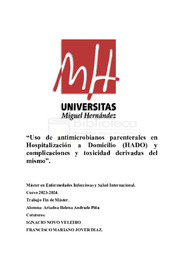Please use this identifier to cite or link to this item:
https://hdl.handle.net/11000/35525Uso de antimicrobianos parenterales en Hospitalización a Domicilio (HADO) y complicaciones y toxicidad derivadas del mismo
| Title: Uso de antimicrobianos parenterales en Hospitalización a Domicilio (HADO) y complicaciones y toxicidad derivadas del mismo |
| Authors: Andrade Piña, Ariadna Helena |
| Tutor: Novo Veleiro, Ignacio Jover Díaz, Francisco Mariano |
| Editor: Universidad Miguel Hernández |
| Department: Departamentos de la UMH::Medicina Clínica |
| Issue Date: 2024-09-06 |
| URI: https://hdl.handle.net/11000/35525 |
| Abstract: Introducción y objetivos: El tratamiento antibiótico endovenoso domiciliario (TADE) es una opción alternativa a la hospitalización convencional cada vez más utilizada debido a las ventajas que supone para el paciente y para el sistema sanitario. El progresivo envejecimiento de la población y aumento de la complejidad de los pacientes hace que el abordaje de algunos tratamientos en las unidades de Hospitalización a Domicilio (HADO) sea un reto, por lo que la disponibilidad de datos sobre la evolución de los pacientes y la seguridad de las intervenciones terapéuticas en esta modalidad se hace fundamental para la correcta toma de decisiones. En este sentido se plantea este estudio, cuyo objetivo fundamental es la descripción del uso de TADE en una cohorte de pacientes ingresado en HADO y el análisis de posibles complicaciones. Material y Métodos: Se realizó un análisis retrospectivo de todos los pacientes ingresados en HADO para TADE en un periodo de 1 año. Se recogieron datos epidemiológicos y clínicos, así como sobre la evolución de los pacientes y desarrollo de complicaciones, incluida mortalidad, reingreso al mes y eventos adversos.Resultados: Fueron incluidos 301 pacientes (59,5% hombres) con una edad media de 74,7 años. El servicio de procedencia más frecuente fue Urgencias con el 27,9%, seguido del 22% de Medicina Interna. Un 10,3% residían en centros sociosanitarios. Los diagnósticos más frecuentes fueron infecciones de vías urinarias en 112 pacientes (37,2%) y respiratorias en 94 (31,3%). En el 34% de los pacientes se aislaron bacterias multirresistentes y la vía de administración más frecuente fue intravenosa periférica en un 77% de los casos, línea media/PICC en un 17% y subcutánea en un 10,6%. La perfusión con bombas elastoméricas se empleó́ en un 42% de los pacientes; el antibiótico más frecuentemente utilizado fue la ceftriaxona (27,9%), seguido de ertapenem (24,6%) y piperacilina-tazobactam (20,6%). Las complicaciones relacionadas con la vía de administración ocurrieron en 33% de los pacientes, la mayoría fueron la necesidad de cambio de vía por obstrucción (23,6%) y flebitis (10,6%). Las complicaciones relacionadas con el fármaco ocurrieron en el 5,3%, ninguna reacción fue grave en ningún paciente. En cuanto a la evolución, la tasa de mortalidad fue de 9,3% y reingresaron al mes por la misma patología el 11,7%. Algunas comorbilidades se asociaron significativamente a mortalidad (cardiopatía, EPOC, ERC, anemia y Barthel <20), reingreso por la misma patología (anemia, cáncer, enfermedad hematológica, inmunodepresión y residir en centros sociosanitarios) y aparición de complicaciones (caquexia y residir en centros sociosanitarios).Conclusiones: El tratamiento de los pacientes con enfermedades infecciosas mediante TADE es una alternativa segura que debe considerarse en los protocolos de actuación de los centros hospitalarios ante cualquier tipo de infección y tratamiento antibiótico. Introduction and objectives: Home intravenous antibiotic treatment (OPAT) is an increasingly used alternative option to conventional hospitalization due to the advantages it offers to the patient and the health system. The progressive aging of the population and the increase in the complexity of patients makes the approach to some treatments in Home Hospitalization (HADO) units a challenge, so the availability of data on the evolution of patients and the safety of therapeutic interventions in this modality becomes essential for correct decision-making. In this sense, this study is proposed, whose fundamental objective is the description of the use of HAT in a cohort of patients admitted to HADO and the analysis of possible complications.Material and Methods: A retrospective analysis of all patients admitted to HADO for HAT in a 1-year period was performed. Epidemiological and clinical data were recognized, as well as data on the evolution of patients and development of complications, including mortality, readmission at one month and adverse events.Results: A total of 301 patients (59.5% men) with a mean age of 74.7 years were included. The most frequent service of origin was Emergency with 27.9%, followed by Internal Medicine with 22%. 10.3% resided in social health centres. The most frequent diagnoses were urinary tract infections in 112 patients (37.2%) and respiratory infections in 94 (31.3%). Multiresistant bacteria were isolated in 34% of patients and the most frequent administration route was peripheral intravenous in 77% of cases, midline/PICC in 17% and subcutaneous in 10.6%. Infusion with elastomeric pumps was used in 42% of patients; The most frequently used antibiotic was ceftriaxone (27.9%), followed by ertapenem (24.6%) and piperacillin-tazobactam (20.6%). Complications related to the route of administration occurred in 33% of patients, the majority being the need to change the route due to obstruction (23.6%) and phlebitis (10.6%). Drug-related complications occurred in 5.3%, and no reaction was serious in any patient. Regarding the evolution, the mortality rate was 9.3% and 11.7% were readmitted within one month for the same pathology. Some comorbidities were significantly associated with mortality (heart disease, COPD, CKD, anemia and Barthel <20), readmission for the same pathology (anemia, cancer, hematological disease, immunosuppression and residing in social-health centers) and the appearance of complications (cachexia and residing in social-health centers).Conclusions: Treatment of patients with infectious diseases using OPAT is a safe alternative that should be considered in the protocols for action of hospitals for any type of infection and antibiotic treatment. |
| Keywords/Subjects: infusión intravenosa en el hogar hospitalización a domicilio bombas elastoméricas home intravenous infusion home hospitalization elastomeric pumps. |
| Knowledge area: CDU: Ciencias aplicadas: Medicina: Patología. Medicina clínica. Oncología |
| Type of document: info:eu-repo/semantics/masterThesis |
| Access rights: info:eu-repo/semantics/openAccess Attribution-NonCommercial-NoDerivatives 4.0 Internacional |
| Appears in Collections: TFM-M.U Enfermedades Infecciosas y Salud Internacional |
.png)

